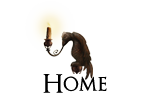Scribble City Central's thirty-fifth Fantabulous Friday A-Z comes from Philip Womack, ace journalist, reviewer, blogger, Classicist and writer of two excellent novels for children. The second of these - The Liberators - brings the Dionysian cult of the maenads (or Bacchae if you're talking Roman gods) into a modern day London.
Maenads have appeared in children's literature before - C.S.Lewis features a sanitised version in Prince Caspian, and, more recently Rick Riordan has them partying in The Demigod Diaries - but Philip's version of them goes back to the raw, dark, savage originals visualised by Euripides in The Bacchae. While I've never been the maenads greatest fan - objecting to the intemperate way they tore poor Orpheus apart - The Liberators is a book which I enjoyed immensely, not least because it's good to find another author who is as much of a Greek myth buff as I am. It's hardly surprising that Philip really knows his myths, given that he has a Classics degree from Oxford, and I'm hoping there'll be more myth-based children's books from him in due course, because he can really write. He's also an excellent person to give you the full lowdown on the party animals that are:
S for Satyrs
Sons of Silenus
PW: If you go to the Royal Academy whilst its fabulous Bronze exhibition is in place, you’ll see, dredged up from the bottom of the sea, a satyr, a member of the sacred band of Dionysus, the god of wine, dancing in abandon. He’s rather good-looking, and well-proportioned, for a satyr – you wouldn’t think he was one, were it not for the hole where his tail ought to be.
They’re a strange bunch, satyrs, flitting about the woodland, immortal and lascivious. Their father is the drunkard Silenus, whose fat figure can be seen in the background of Titian’s Bacchus and Ariadne, propped up on a donkey. Now there’s a man who knows how to have fun.
His offspring are equally vivacious. They weren’t always goatish; they used to have horse-tails; and they were sometimes called Silens; but what is constant about them, if such a thing can be so, is their ambivalence. They are convivial, and accompany the mysterious god Dionysus; but they are also loutish and base. They are animals; and yet they are capable of making beautiful music. They prance and caper about; and yet they are repositories of wisdom. If you trap a satyr, or a faun (their close cousins) in your garden, he will tell you that the best thing for man is not to have been born; the second best thing is to die quickly. King Midas did it, and that’s what he learned.
It is thanks to satyrs that we have tragedy at all – the first Greek plays had choruses of the creatures. Their lusty, louche presence rounded off every performance of a tragedy in Athens, as they had their own genre – the satyr play, a burlesque in which heroes would be made to look a little less heroic. They sit on the sidelines of the world, grinning, mocking, fierce.
Satyrs are the first beings to taste the wonders of wine, to sing to the lyre of Orpheus, to pipe ghostly music in the moonlight.
My second book, The Liberators, features the Titian painting of Bacchus and Ariadne. The Luther-Ross brothers find the staff of Bacchus and use it to remove people’s consciences: they create their own band of glamorous but deadly satyrs. Of course they have nothing of the true, joyous Bacchic spirit, so they are overcome. Bacchus would not accept the Luther-Ross brothers in his band.
Satyrs are wisdom and wildness and wine. They remind us of our animal natures, and yet they show us that we can be more than that. They are us, and not us; they are the raging id; they enchant us with their frenzied music, but they can also destroy us. They embody the mystery and glory of Bacchus / Dionysus.
If you met that handsome dancing satyr in the middle of his ecstasy, he would no doubt tear you to pieces. But I’d still recommend going to see him, trapped as he is in bronze centuries old, and you’ll be able to feel the touch of the god in his eyes. Ask him a question. He might just answer.
SCC: Thank you, Philip - I shall certainly go and see the Bronze exhibition and ask that satyr a question. It's good to be reminded of that strange dichotomy of the cult of Dionysus as both a glorious jolly party and a madly savage riot. I'm pretty sure that the god is hovering at the edges whenever there's a present day rave in a field - his satyrs would fit right in with the technobeat.
If you like the sound of The Liberators, you can buy it HERE.
NEXT WEEK: I'm hoping the wonderful Michelle Lovric will be here to talk about S for Sirene, but if not, it will be me with a Spooky S for Surprise instead.
NEXT WEEK: I'm hoping the wonderful Michelle Lovric will be here to talk about S for Sirene, but if not, it will be me with a Spooky S for Surprise instead.





















1 comment:
Very much enjoyed this. Interesting that the wild 'other' satyrs ripped people apart in frenzy. Shamans, as part of their journey, often 'experiences' in trance or dream, being torn apart by their totem animal or some other supernatural visitant - and then they were rebuilt, as it were.
When Orpheus is ripped apart, is he undergoing a shamanic rebirth?
Post a Comment